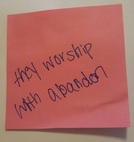 It can be challenging to worship with children, but it is also supremely glorious to worship as a whole, holy Body of Christ. In fact, when I ask people to list the blessings of worship with children, I always receive an enthusiastic and varied response. Here are some of my favorites: It is a blessing to worship with children because...
What I love most about worship with children is how it changes the adults. Kids free us to be a little silly. They allow us to do things we wouldn't normally do - like dance or color or blow bubbles or listen to a storybook - because "it's for the kids." Guess what? It's not just for the kids. Children learn by listening, seeing, and doing - and so do adults! When the child behind you sends her entire bucket of crayons skittering across the floor, grab one for yourself. Draw the story of the scripture or try to distill the message of the sermon into a simple picture. Give it to the child - but not before you let that image take root in your own heart.
3 Comments
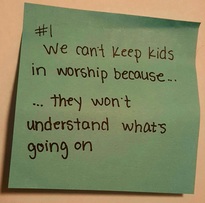 In my workshops, I often ask folks to complete this sentence: "We can't worship with children because..." And let me assure you, we have no trouble coming up with a long list of reasons why kids should should stay out of the sanctuary.
I don't mean to make light of these fears because they are both honest and (usually) true. Kids are loud and messy. They have a tendency to ask questions at inopportune moments. Church can be boring for kids (and adults too)! Children can't understand the language and symbolism in much of the service. But how much of worship - the intersection of divine glory and human awe - do any of us truly understand? Christina Embree says, "{church is} a total package. And much of what is included in that package is not comprehended through the mind, but through the heart." Worshipping with kids isn't easy. It's important that we recognize the challenges so that we can also embrace the gifts children bring to our church. Make sure to read part 2: "Top 10 Blessings of Worship with Kids."  Bread of Life + Glitter = Disco Grace Bread of Life + Glitter = Disco Grace Children in a sacred space can be distracting, but worship is not about our experience – be it beautiful or broken. Worship is about God. It is not always easy to welcome these wiggly wanderers into our sanctuaries, but when we do, kids transform our worship of the Living God with their unique gifts:
So the next time kids ruin your worship, will you sigh and start crafting an email to their parents or the pastor in your head, or will you chuckle and start looking for the Spirit in the midst of the mess? Choose freedom over frustration. Choose grace. Allow the little ones to transform you into something bigger, more beautiful and more powerful than you ever imagined - the Church. “Potty” is not a word you typically hear in a sanctuary. Potties are for preschoolers and mommies, for sticky fingers and training pants, for lisped emergencies and unseemly accidents. A “potty” does not belong among the pews and polished shoes of our most sacred spaces. But there it was - like nails on the chalkboard of our nice, smooth church service. “Mommy, can I go to the potty?” Every head in the congregation whipped toward my three year old, shifting their focus from the proclamation of the Word to the proclamation of the potty. I wanted to sink into the crimson carpeted floor - or rush her out the side door - but I couldn’t. Because I was in the middle of preaching my first sermon in a new church! With my husband serving another congregation and room full of strangers giggling nervously or rolling their eyes, I continued, determined to preach the gospel - regardless of preschoolers and their bathroom needs. As my daughter skipped down the center aisle, carrying her sparkly little purse and our orderly worship with her, an unfamiliar older woman slipped out of her pew in hot pursuit. And we all breathed a sigh of relief. 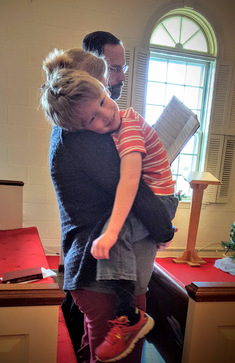 Because we are the Body of Christ and sometimes part of the body has to pee, but that does not make her worthless. Sometimes part of the body can no longer climb the stairs to the sanctuary, but that does not make him obsolete. Sometimes parts of the body might need an oxygen mask, or a hearing aid, or crayons, or an extra explanation, but that does not make them a nuisance and it certainly shouldn’t keep them out of worship. Children are a loud and messy part of the body. Their shrieks pierce our holy silence. Their pencils skitter across the floor. Their whispered questions sound more like shouts. Their cracker crumbs infest every crevice within 10 feet of their squirmy little bodies. Kids crunch and cry and crawl up into our holiest of spaces, and God meets them there. God meets us there,”Let the children come to me.”Jesus gathers the little ones into his arms and implores us all to join them in their wonder, their joy, their hopefulness - even their messiness - "for it is to such as these that the kingdom of God belongs" (Mark 10:14). On my first Sunday at this wonderful little church, my daughter distracted us from our order of worship, but she could never distract us from God. When she and her new 80 year old friend marched back up the aisle hand in hand, beaming with holy delight, we all felt the embrace of the Holy Spirit drawing us into community, nestling us into the very heart of God. Our littlest members can make the biggest impact in transforming our church into what God calls us to be - a messy and miraculous body of believers. So the next time a child pulls your focus from the liturgy or the sermon or the prayer, look for God. In the grandfather’s smile, in the mother’s coos, in the sister’s laugh or the friend’s helping hand, God is there, welcoming the little ones - and the big ones too! 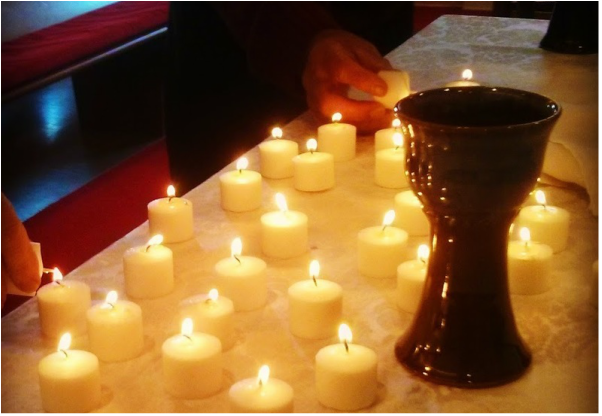 “Mommy, can I get some candy?” “Yes,” I replied, undaunted in my attempt to preach the Word. My almost four year-old daughter had recently discovered two things: 1) There is a bowl of hard candy in the church office and 2) Mommy isn’t really interested in teaching a lesson about nutrition or risking a meltdown in the middle of a sermon. This was not the first time I received such a request, but when I saw a usually placid face on the front row contort with shock and fear, I knew something was terribly wrong. I whipped around to find my little girl balancing on tip-toe at the communion table. One hand gripped the table cloth laden with lit votives, while her brown curls and pudgy fingers trembled as she attempted to set her own candle aflame. Instantly, I was by her side calmly explaining that she could not light a candle nor take it back to her pew. I pointed her toward the stash of flameless tea lights I gave her before worship and handed her two unlit votives which she accepted with a resigned sigh. Disaster averted. It was All Saints Sunday a year ago. She learned about fire. I learned “candy” and “candle” sound remarkably similar! It is all part of the learning process as we embrace the joys and the challenges of worshiping as a cross-generational community. We believe it’s important for children to worship with adults, but we’re also learning it’s good for adults to worship with children. In our age-segregated society, many adults don’t have the opportunity to interact with children. We don’t have to deal with the baby’s cries, but we also don’t get to hear her laugh. We miss the child’s impatient wiggles, but we also miss his thoughtful questions. When we move the children out of the sanctuary, it’s like worshipping blindfolded. It might be easier to concentrate, but it’s harder to be distracted by beauty, by joy, by wonder, by heart-wrenching sobs and by soul-tending love. Last summer we held a holy parade in our sanctuary to celebrate God’s presence among us. Like David dancing before the Lord, the children decorated bikes and rode them up the center aisle leading in the bread and cup. I didn’t get to see much of the children, but I couldn’t miss unbridled joy on the faces of the adults. Worshiping with children gave the adults permission and courage to respond authentically to God’s powerful presence. The kids freed us to worship with wild abandon! On that All Saints Sunday a year ago, when my child very nearly lit the church on fire, we experienced the great challenge and gift of worshipping with children. We learned her actions – while distracting – did not ruin worship. Worship is not about our experience – be it beautiful or broken – it is about God. Children might not know the word “sacred,” but they understand the holy power of worship. Their presence enriches our experience, deepens our knowledge, and magnifies our joy. When I sat down next to my daughter for the final hymn that Sunday, I saw she completed a communion puzzle, joining the broken bread and jagged cup, piecing together the holy words. Eleven tea lights flickered with battery-powered might and the two unlit votives completed a circle around the fragmented whole. “Remember me.” And so we remember. We celebrate, pray and sing. We worship with all the saints. We had a crazy awesome holy parade this morning!
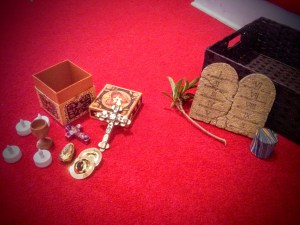 Ark of the Covenant worship exploration Ark of the Covenant worship exploration I create the Family Worship Guide every week to help facilitate inter-generational worship at Faith Presbyterian Church in Greensboro, NC. You may use this content with attribution. Family Worship Guide – Sunday, July 5, 2015 “A Holy Parade” – 2 Samuel 6 Parents, use this guide to help your young child remain engaged throughout the worship service.There are ways to explore and interact in the Family Worship Area at the front of the sanctuary. You may also use this guide in your pew. We Gather in God’s Name – Worship Exploration
We Proclaim God’s Word
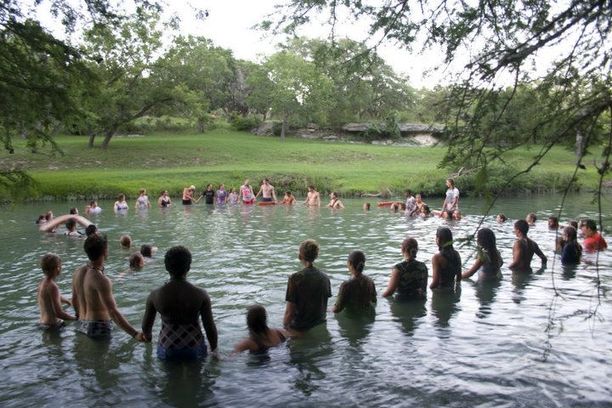 Worship in the river at John Knox Ranch Worship in the river at John Knox Ranch Psalm 29 deals with God’s power with particularly strong imagery around floods. God “shatters the cedars of Lebanon… convulses the oaks…. strips the forests bare… shakes the wilderness…sits enthroned atop the flood waters…” These images are meant to amaze us with God’s power, possibly to comfort us that even in our weakness God is mighty. But I can’t help but be reminded that Fear is the cousin of Awe. All these images of floods are striking a raw spot for me right now. For the last week, my newsfeed has been filled with pictures of pounding flood waters in central Texas, cedars shattered and cypress trees ripped from their roots, oak trees stripped bare. The human debris is just as staggering. Foundations lay empty – the homes that once graced their bedrock, gone. Just gone. Pictures and clothing and silverware litter the ground, snatched by the river then dropped as the current twisted and turned through the heart of Texas. This particular area of central Texas is very dear to my heart. I spent 15 summers at John Knox Ranch, a summer camp near Wimberley, on the banks of the Blanco River – which is usually cool, clear and calm. It’s my favorite place to swim on Earth! Rob and I were married at John Knox Ranch and I swam in that river just hours before my wedding. The camp dining hall where we had our reception is about 100 yards up a gentle slope from the river. There were trees and a road separating the two so you couldn’t even see the river from the dining hall. Once when I was a camp counselor, we saw the river rise to the edge of the field, about 50 yards away. And even then, we were told that it reached its 500 year flood plain. So it hadn’t been that high in 500 years! Saturday night, I heard the dining hall was under 20 feet of water. It’s unimaginable. This area of the Blanco isn’t bordered by canyon walls or cliffs or mountains. It’s rolling hills and wide river plains. I never thought if it as “flash flood” country. More like, “we’re watching the river rise” country. So a 40 foot wall of water was absolutely devastating. I have friends whose homes were totally destroyed. I heard that one friend and her husband were rescued by a boat in the middle of the night while they were clinging to their second story window sill. Thank God that boat came before the house went. Three families from my home town were vacationing together in a house on the Blanco River. The flood lifted their home from its stilts and swept them away. In a matter of minutes, all that tied them to this earth was gone. Just gone. A father survived. The two mothers, a child, and two grandparents have been recovered. The rest – one father and two young children – are still missing. In the face of this loss, this complete destruction, I have a tough time with the image of God sitting enthroned atop the flood waters. It is not comforting and it certainly doesn’t fill me with awe. It is scary and horrible. It is a perversion of everything I expect from a loving God. I know that God created the world and all that is in it – the grand cypress trees and the limestone cliffs, the grassy plains and the shady oaks, the cool clear water and the mighty torrent. But I simply can’t believe these floods were some sort of display of power – a show, meant to fill us with awe and fear. This is always the fine line we walk with natural disasters: If we believe that God is all powerful – and we do – if we believe that God is sovereign over all the earth – and we do – if we believe that God created the world and all that is in it – and we do – then how can we say this is not of God? How can we say that hurricanes and tsunamis and earthquakes and tornados and floods are not at best, part of some unknowable master plan or at worst, God’s judgment? I do not believe that. I cannot believe that. We proclaim that death has died, that light outshines darkness, that the lost will be found, and I will not equivocate and say, “Oh, but these losses, this death, that’s part of God’s plan. God needed another angel in heaven.” God doesn’t need anything. Need is a human experience and God is the provider, the comforter, the protector. God is the savior, not the one from whom we must be saved. Always. Because – more than anything else – God is love. Full stop. And that LOVE is mightier than raging river and deeper than a roiling chasm. It pierces the night like a bolt of lightning illumining the cloud filled skies. It rumbles over the face of the earth shaking the ground with its message – a message not of fear, but of love–“Fear not, my beloved children. I am here.” When I think of those families tossed about the rising water, the darkness of the night, the power of the current, I cannot bear to imagine it. But I also can’t stop from thinking about it, about all of them – mothers and fathers, grandparents, little children so close in age to my own… terrified and alone. It is absolutely horrifying, and it is also completely impossible. Because God is love. And love does not leave when the water rises. Love doesn’t disappear when it seems all is lost. Perfect love casts out all fear and even death cannot stop the living. So how do we reconcile our tragedy with God’s love? We have faith, and we don’t turn away from the unimaginable – and this is where our images of the Triune God become really powerful, because those beloved children of God were not alone in the flood waters. And wherever they are now – in heaven or on earth – they are not alone. None of us are. Ever. When we face our fear and follow God into that dark and stormy night, we see the light of Christ beaming through the inky blackness and his grace, so amazing and warm, radiating from their fragile, beautiful bodies. We see the breath of the Holy Spirit entering their lungs and her powerful current flowing all around them. We see God the Father encircling them with his mighty arms keeping the fear at bay, and God the Mother gathering them under her wings, holding them close, and whispering in their ears, “fear not my beloved child. I am here.” And so they were born, of water and the Spirit, into the dwelling place of peace. May it be so for us all. This piece is a sermon preached 3/31/15 at Faith Presbyterian Church, Greensboro, NC. My post from Hope4CE, a website to exchange and promote new ides for church and Christian education.
------------ At Faith Presbyterian (https://www.facebook.com/faithpresgso), we embrace our traditional worship style and space while making our service accessible and engaging for all. Children and their families are welcome at the front of the sanctuary with activities geared toward their age level. Our family worship guide follows the pattern of the service and offers extra enrichment ideas and activities for children and active learners of all ages.The outline of a traditional worship service centered around The Word is beautiful and quite freeing when we remember that The Word is The Living Word of God – incarnate in Christ, written in scripture, and enacted in the world. For Lent, we are using a themed sermon series inspired by Rev. Whitney Wilkinson following the “Landscape of Lent.” Each week, we add a new visual element to represent some aspect of the scripture – ashes, wilderness, wind, water, mud, cave, palms, bread – and we will close with Easter in the garden.... ------------- Read the whole post on HOPE4CE. 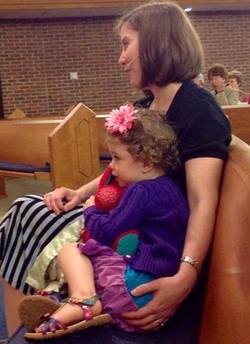 Worshiping Together Worshiping Together Dear 3-year-old-girl-of-mine, I took your curly headed, rainbow-glitter sandaled, stuffed animal toting self to worship on Sunday. We sat in the first pew because that’s where you wanted to sit, and it helps keep you close to the action. You come to church almost every Sunday, but you very rarely come to worship. Your Mommy and Daddy are both pastors, and so we are usually busy. We can’t be there to sit with you and sing with you and pray with you and answer your questions, so you’ve been staying in the nursery with your little brother, but that’s going to change. You know a lot of important things about church: you know that it’s fun and has lots of friends – some younger than you and some older, some much older; you know that you are loved by all your church friends; you know it’s a place to learn about God; you know it has a great playground, beautiful flowers, and a wonderful garden full of food; you know that it is safe; you know that it’s your church, but it’s also my church and other people’s church and God’s church, so we call it our church. But you don’t know a lot about our traditional worship, because you aren’t there. I’m going to change that. Here are 5 reasons why: 5) Because of the music. Where else can a child – or anyone for that matter – hear piano and choral music – classical and contemporary – performed excellently not for the glory of self but for the glory of God? Music offered as an act of worship lifts your soul and brings you into the presence of God. You love the music. You love it so much that you want to sit in the front of the sanctuary so you can be as close as possible to the musicians, so you can watch and worship with rapt attention. 4) Because of the singing. You aren’t sure about the singing. You did not want to stand, and so we sat with the hymnal and I tried to sing loud so you could hear my voice. I worry that you are timid about singing, and church is a great place to find your voice. When the sanctuary is full of song – the piano playing, the many voices of the gathered congregation lifted in praise – you can make a joyful noise as part of the whole. You don’t have to worry what others will think. You don’t have to worry if you are singing the right melody or the right words, you can just sing. 3) Because of the prayers. We pray before meals and before bed, sweet memorized prayers that are so important in childhood, but you need to know there are many ways to pray. You need to hear prayers that use some words you understand and some words you don’t. You need to hear prayers from me and also your dear friends and mentors leading worship. You also need to hear the prayers we all say together, even if you can’t read along yet, because they speak the truth about us and about God. You know that God is good and loving and forgiving. You know that sometimes you make a mistake and then you are forgiven. These truths are not new to you, but you need to know that they are true to everyone. We praise God together. We confess together. We receive forgiveness together. Because we all need it. 2) Because you want to be there, and you are wanted there. I’m not going to keep you out because it’s inconvenient anymore. Jesus said, “Let the children come to me” and I’m not going to stand in the way of Jesus. But also, the other people in worship want you there. As we walked up the center aisle to that front pew, I watched their faces light up. They were excited to share this experience with you! When you come to worship, you bring your whole self – just like everyone else brings their whole self. You bring innocence, curiosity, and joy. You bring restlessness, shyness, boldness, happiness and sadness. Who you are is important to who we are. You make our worship more complete. 1) Because it’s not about you, it’s about God. So much of our lives revolve around you – from the moment you wake until you go to sleep at night, your life is full of people focused on you, caring for you, teaching you, playing with you. You are the center of your world, and that’s developmentally appropriate. But as you grow into a wider understanding of who you are in the world, I want you to find your center in God. You are old enough to feel the pull of the Divine, to reorient your focus – if just for a moment – to the Perfect Love which casts out all fear. You don’t have to understand the Holy Mystery – in fact, you will never understand it – but you can experience it. So my darling, we are going to go to worship, and once your little brother gets a little older he is coming too. Get excited! All my love, Mommy This post is edited from the original post on http://www.covenantpcusa.org/blog in May 2014 after I began bringing my daughter to worship. We are at a new church now http://www.faithpresgso.org She worships with us every week and stays through the entire service. It is a little crazy, but ridiculously wonderful. |
SubscribeDon't miss out on any great content or events!
Categories
All
|
Site by King Communications
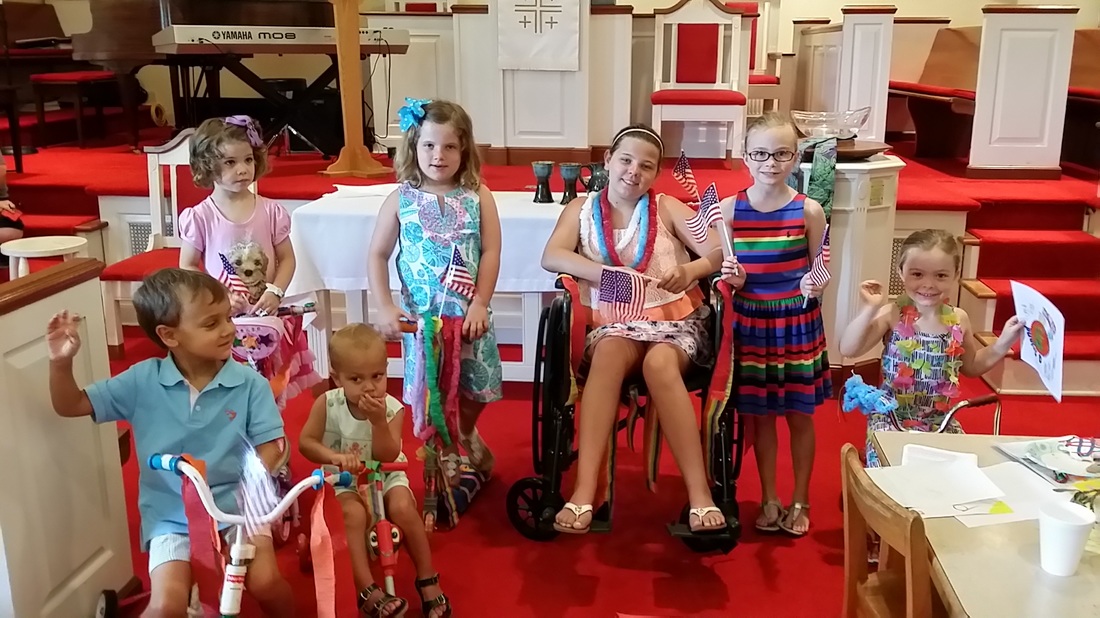
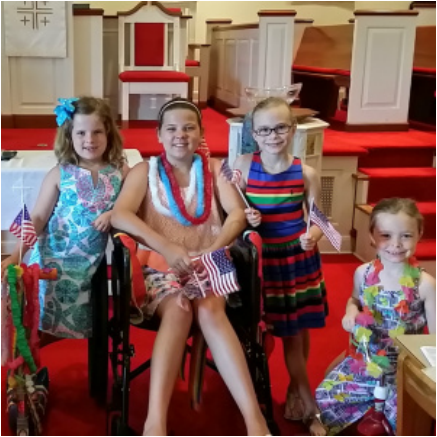
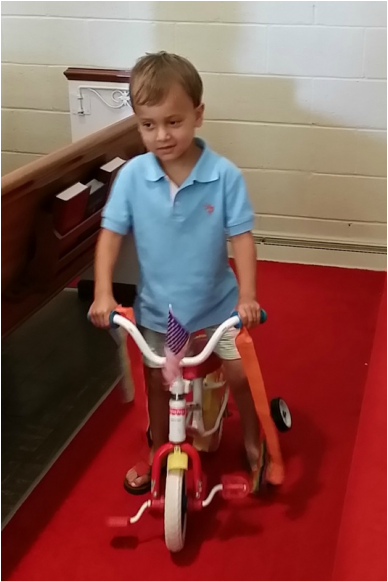
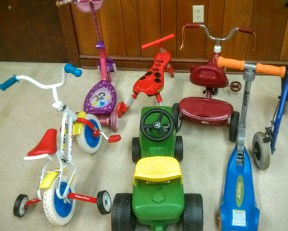
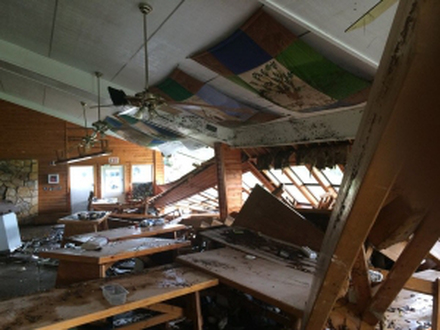
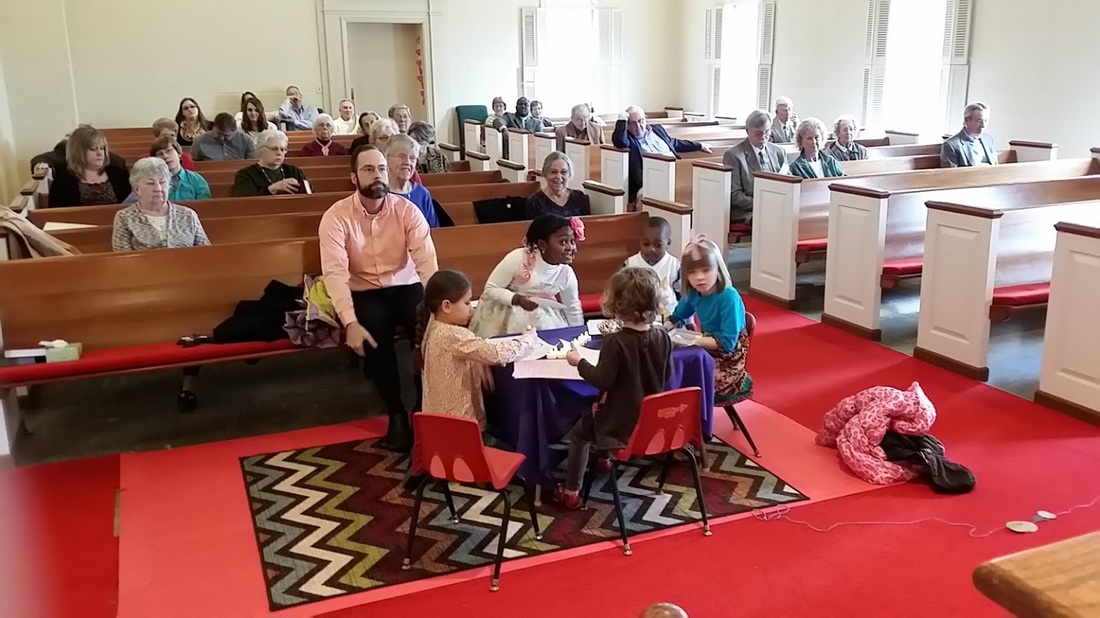
 RSS Feed
RSS Feed